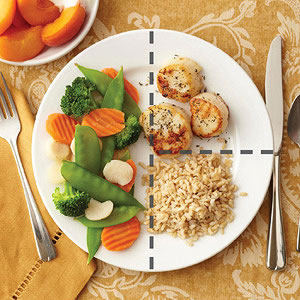
Esalen's First Yoga Teacher — Teaching yoga since 1968
Considering Starting a Diet? Read This First
BY SARAH MINKOW, MS, RDN
|

|
The truth is, fad diets do not work. They sometimes show results in the short term by simply eliminating entire food groups, so you automatically eat less. Moreover, the rules are almost always hard to stick to and, when you stop, you regain the lost weight.
Rather than rely on such gimmicks, here are 16 evidence-based keys for successful weight management. Not all these suggestions will work for everyone. Pick and choose those that feel right for you. Note that this is not a "diet" and that there are no forbidden foods. The goal should be to establish a healthy relationship with food, and a long-term eating pattern that is realistic, enjoyable, and sustainable.
- Start with a balance of healthy foods like vegetables, fruits, whole
grains, legumes, lean proteins and healthy fats.
Limit refined grains, sugary foods, and saturated and trans fats. A good visual
aid to use is the Plate Method which recommends filling
half your plate with vegetables and fruits. Starches (preferably starchy vegetables,
such as potatoes, or whole grains) and protein foods should each take
up about a quarter of the plate.

Image courtesy of Almuerzos y cenas saludables | Nutrición Actual - Eat mindfully. This involves increasing your awareness about when and how much to eat, using internal cues to guide you. Eating mindfully means giving full attention to what you eat, savoring each bite, acknowledging what you like and do not like, and not eating when distracted (such as while watching TV or working on the computer). This will help you eat the right amount of food for you, while you enjoy your food more.
- Eat slowly, chew well. A component of mindful eating, this allows more time for satiety signals to reach the brain (it takes about 20 minutes), which will help you feel fuller and eat less. In addition, eating slowly makes you more aware of the smell, taste, and texture of the foods, which can lead to greater satisfaction. Keep in mind also that the most pleasure often comes from the first few bites of a food, thus, focus on those first few tastes of chocolate, cake, or other indulgences, as this may be enough to satisfy.
- Do not rely on willpower. Instead, control your food environment so that you do not unconsciously eat when you are not hungry. For example, do not keep indulgent foods at home, or at least keep them out of sight (such as on a top shelf or in the back of the fridge) and change your routines so you do not regularly encounter temptations (such as avoiding your work's enticing pantry). Use smaller plates, bowls, cups, and utensils, and portion out snacks into small bowls or bags from larger boxes you can always have more later if you decide you are still hungry.
- Identify emotional triggers that may be making you overeat. For example, you may eat more when you are stressed, upset, anxious, or lonely. To distinguish between physical and emotional hunger, rate your hunger level before, during, and after eating on a scale of 1 to 10, with 1 being "starving" (with associated headaches and weakness) and 10 being "uncomfortably full" (as in after-Thanksgiving-meal stuffed). Ideally you should eat when you are at level 3 (hungry but not yet uncomfortable) and stop at level 6 (satisfied, slightly full). If you often eat for reasons other than hunger, find pleasurable non-food-related self-care activities that you can do instead, such as going for a walk, calling a supportive friend, doing some stretching, or giving yourself a foot rub.
- Get some protein, fiber, and unsaturated fat at each meal, since these foods increase satiety. Look for sources of lean protein (such as beans and other legumes, white-meat poultry, and dairy), healthy fats (such as fish, nuts, avocado), and fiber-rich plant foods (like whole grains, legumes, fruits, and vegetables).
- Eat regularly (do not skip meals). Many people find that going longer than 3-4 hours without food makes them more likely to overeat later (often on high-calorie treats). Find a meal-timing pattern that works best for you. If you eat between meals, plan ahead for healthful snacks, such as Greek yogurt with a handful of berries; hummus with carrots; or some cheese and turkey on a whole-grain pita and bring these with you.
- Drink water. Water is involved in every bodily function including digestion, metabolism, and the excretion of waste products, and needs to be frequently replaced. Sometimes thirst is mistaken for hunger, and water is the best choice to satisfy thirst. Be aware that sweetened beverages and alcohol contain empty calories that do not fill you up, and alcohol can have a disinhibiting effect on eating control.
- Cook at home often. Cooking allows you to eat more whole, unprocessed foods and control how much oil, sugar, and salt is used. Furthermore, restaurant portion sizes are often twice as big as home-cooked meals.
- Choose wisely when eating out. Look for veggie-rich options that fit the Plate Method. Consider sharing entrées (or asking for half to be wrapped to take home before you start eating) or have an appetizer or salad as your main dish.
- Allow for occasional indulgences. Overly restricting foods can be counterproductive since it can increase your desire for them and leads to bingeing. Having an occasional treat is fine, just do so with intention and mindfulness. You might, for instance, have a small daily treat such as a few squares of dark chocolate or cookies that you pre-portion out and then put the package away.
- Keep a food diary. Recording what you eat helps you to notice patterns and eat more mindfully. To fully utilize a food journal, write down the food items you eat for every meal and snack and note how you feel after eating. You may find connections between certain foods and how you feel afterward. No need to track calories—this is burdensome, highly inaccurate, and often anxiety-producing.
- Get enough sleep. Sleep habits are often an overlooked factor in body weight. Fewer than six hours of sleep per night may affect appetite hormones and lead to increased food intake, decreased calorie burning, and increased fat storage.
- Get regular physical activity. One of the best things we can do for our health is to get some form of exercise every day. No need to kill yourself at the gym—simply incorporate daily body movement that feels good. Walking is great. Build it into your life—take walks on your lunch break, park your car in the farthest away spot, and take the stairs instead of the elevator. Strength training is also important. In fact, building muscle is one of the only proven ways to increase one's metabolism (sorry, lemon water does not help). Muscle building exercises that use body weight (sit ups, push ups, squats, lunges) can be done anywhere, anytime.
- De-stress. A high level of the stress hormone cortisol has been shown to increase appetite, drive cravings for sugary, fatty food, and slow metabolism. Incorporate regular stress-management activities such as exercise, meditation, and/or therapy into your daily life.
- Set realistic goals and have a realistic body image. Research has shown that genetics may determine up to 80% of one's body shape and size. Also keep in mind that you may never be able to (or it would not be healthy to) get back to your high school weight. Establishing healthy life-long habits, like eating well and getting regular physical activity, is far more important than achieving a certain weight.
Also by Sarah Minkow: Feel Good Food
See also:

Lazy Compost |

Esalen Archives 1960s Photos |

The Invasiveness of Native Plant People |

Pam Walatka |